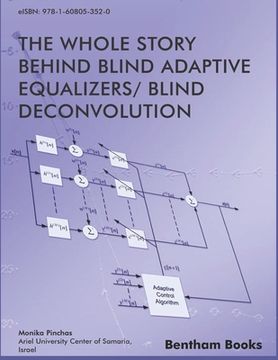Share
Whole Story Behind Blind Adaptive Equalizers/ Blind Deconvolution (in English)
Monika Pinchas
(Author)
·
Bentham Science Publishers
· Paperback
Whole Story Behind Blind Adaptive Equalizers/ Blind Deconvolution (in English) - Pinchas, Monika
$ 95.20
$ 119.00
You save: $ 23.80
Choose the list to add your product or create one New List
✓ Product added successfully to the Wishlist.
Go to My WishlistsIt will be shipped from our warehouse between
Monday, June 03 and
Tuesday, June 04.
You will receive it anywhere in United States between 1 and 3 business days after shipment.
Synopsis "Whole Story Behind Blind Adaptive Equalizers/ Blind Deconvolution (in English)"
It is well known that Intersymbol (ISI) Interference is a limiting factor in many communication environments where it causes an irreducible degradation of the bit error rate (BER) thus imposing an upper limit on the data symbol rate. In order to overcome the ISI problem, an equalizer is implemented in those systems. Among the three types of equalizers - non-blind, semi-blind and blind - the blind equalizer has the benefit of bandwidth saving and there is no need of going through a training phase. Blind equalization algorithms are essentially adaptive filtering algorithms designed such that they do not require the external supply of a desired response to generate the error signal in the output of the adaptive equalization filter. The algorithms generate an estimate of the desired response by applying a nonlinear transformation to sequences involved in the adaptation process. This nonlinearity is designed to minimize a cost function that is implicitly based on higher order statistics (HOS) according to one approach, or calculated directly according to the Bayes rules. The Whole Story behind Blind Adaptive Equalizers/ Blind Deconvolution gives the readers a full understanding on blind deconvolution. The book covers a variety of blind deconvolution/equalization methods based on both cost functions and Bayes rules where simulation results are supplied to support the theory. These include the Maximum Entropy density approximation technique and the Edgeworth Expansion approach used in various blind equalizers. It also describes the relationship between the cost function approach and the approach taken according to Bayes rules. The book deals also with the effect of various system parameters (such as the step-size parameter or the equalizer's tap length) have on the obtained equalization performance. This book will be of particular interest to advanced communications engineering undergraduate students, graduate students, university instructors and signal processing researchers.
- 0% (0)
- 0% (0)
- 0% (0)
- 0% (0)
- 0% (0)
All books in our catalog are Original.
The book is written in English.
The binding of this edition is Paperback.
✓ Producto agregado correctamente al carro, Ir a Pagar.

